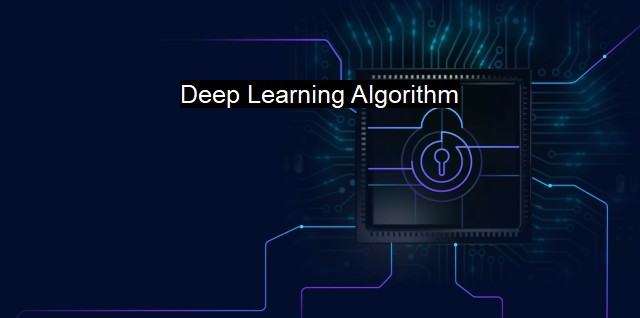What is Deep Learning Algorithm?
Revolutionizing Cybersecurity: How Deep Learning Algorithms are Enhancing Antivirus Applications
Deep Learning Algorithm, a subset of machine learning techniques, is an essential tool in the realm of cybersecurity and antivirus programs that functions by mimicking the processing and decisions-making mechanism of human intelligence. it's a field of Artificial Intelligence (AI) that uses algorithms to make machines do cognitive tasks, such as natural language processing, image understanding, game playing, social network filtering, and so on. These algorithms network operates in a layered structure designed to mirror the human brain's neuronal network.The layers identify various elements of an object, starting from simpler to complex constituents defined through the different layers of the deep learning algorithm. It then combines these characteristics to determine the object. The goal of deep learning and AI is essentially for machines to process, analyze, and draw information, moving towards complete autonomy. In the cybersecurity domain, this means being able to recognize, respond, and detect threats instantaneously on their own accurately.
The application of deep learning has been phenomenally essential, as cyber threats continue to increase both in terms of novelties and complexity. A way to combat these threats more effectively and efficiently is by using this precise power and ability of deep learning algorithm techniques. As recognizing particular pests, assessing abnormalities, noticing potential threats, and pinpoint potential threats requires a considerable amount of analysis, precision, and decision-making capabilities, Deep Learning Algorithms are perfect for the job.
Traditional antivirus software identifies viruses and other cyber threats by matching against an extensive database of known fountain codes. this method may fall short when novel, previously unknown cybersecurity threats novel approaches. This method is severely deficient and enormously challenging when there are novel, previously unknown cybersecurity threats or attacks that present themselves in a novel manner, thus outsmarting and outperforming the antivirus system. Here, ai-powered and deep learning algorithms come into play which through predictive and advanced heuristic patterns, the susceptible threats are detected and neutralized.
Deep learning, in comparison to simplistic methods, can detect ambiguities or abnormalities, enabling preemptive counteractions. Unlike signature-based security methods, which first involve identification, evaluation, and database addition before an attack can be protected against, machine learning anticipates threats even in their morphing stages.
The benefit of a system with machine-learning capacity is it progressively learns from the malware patterns post analysis of massive structured and unstructured data, which makes it competent to predict and ward off future threats in real-time, keeping both the system and data secured from future undetected attacks.
In the world where both cloud-based and on-premises security systems are equally pivotal, AI-powered antivirus tools that use deep learning can enhance the security protocols by leveraging the precision and ability to swiftly detect multiple types of threats. Cryptomining scripts, sophisticated phishing attacks and malware variants uses advanced evasion techniques (AETs) that bypass conventional antivirus protections AI and Deep Learning powered defenses identifies and quarantines them before they impact the system or network.
Therefore, Deep Learning Algorithms have become a powerful weapon for moodern cybersecurity systems in dealing with exceptionally sophisticated threats. By meticulously extracting features and analyzing layered data, they effectively reinforce cybersecurity defenses, challenging the perimeters and creating more robust firewalls to safeguard valuable information systems assets. This sustained reinforcement has, clearly, a profound path forward in the cybersecurity infrastructure. The automation of pattern detection and response decisions using deep machines learning and AI algorithms ensures a stronger and more resilient arsenal in this ever-evolving realm of cybersecurity threats.

Deep Learning Algorithm FAQs
What is a deep learning algorithm?
A deep learning algorithm is a subset of machine learning that involves training artificial neural networks to identify patterns in a dataset. Essentially, it's a type of AI that can learn on its own by processing vast amounts of information.How does a deep learning algorithm work in cybersecurity and antivirus?
In cybersecurity and antivirus, deep learning algorithms can analyze vast amounts of data to identify and predict potential threats. They can recognize patterns in code, network traffic, and other digital activity to detect and prevent attacks. This can provide a more proactive and effective approach to cybersecurity than traditional antivirus software.What are some advantages of using deep learning algorithms in cybersecurity and antivirus?
Deep learning algorithms can detect and prevent new and emerging threats that traditional antivirus software may not recognize. They can also adapt and improve their accuracy over time as they learn from more data. This can greatly enhance the overall security of a system or network.Are there any limitations or potential drawbacks to using deep learning algorithms in cybersecurity and antivirus?
One potential limitation is that deep learning algorithms require a large amount of data to train effectively. This means that they may not be as effective in detecting new threats until they have been exposed to a significant amount of data. Additionally, because they are based on complex mathematical models, they can be computationally expensive and require powerful hardware to operate efficiently. There is also the possibility of false positives or false negatives, which can result in either unnecessary alerts or missed attacks.| | A | | | B | | | C | | | D | | | E | | | F | | | G | | | H | | | I | | | J | | | K | | | L | | | M | |
| | N | | | O | | | P | | | Q | | | R | | | S | | | T | | | U | | | V | | | W | | | X | | | Y | | | Z | |
| | 1 | | | 2 | | | 3 | | | 4 | | | 7 | | | 8 | | |||||||